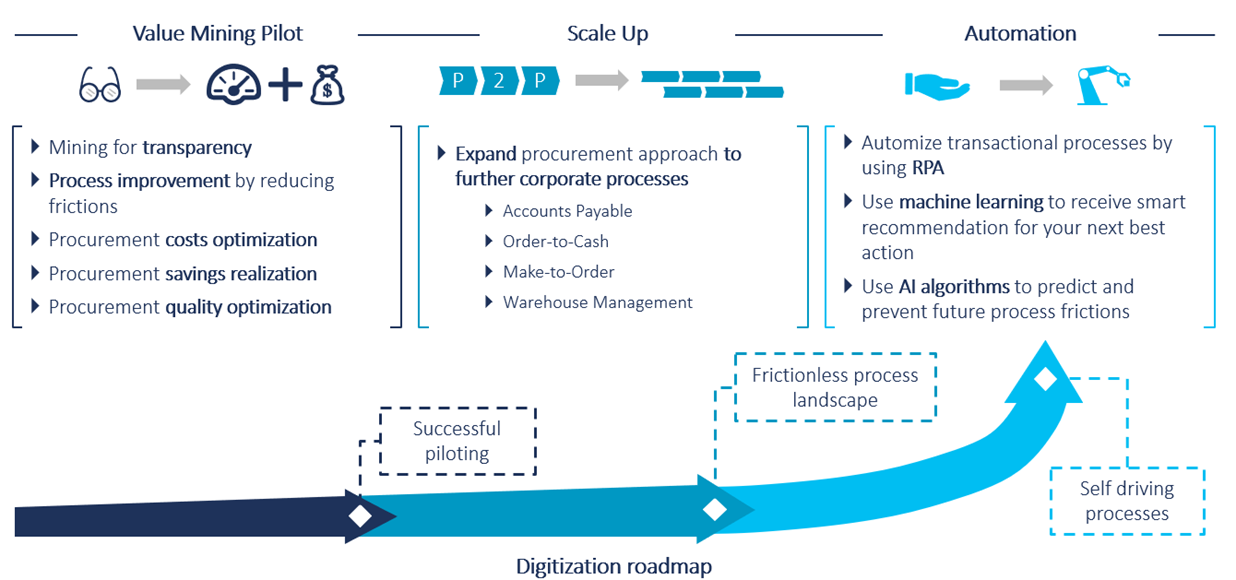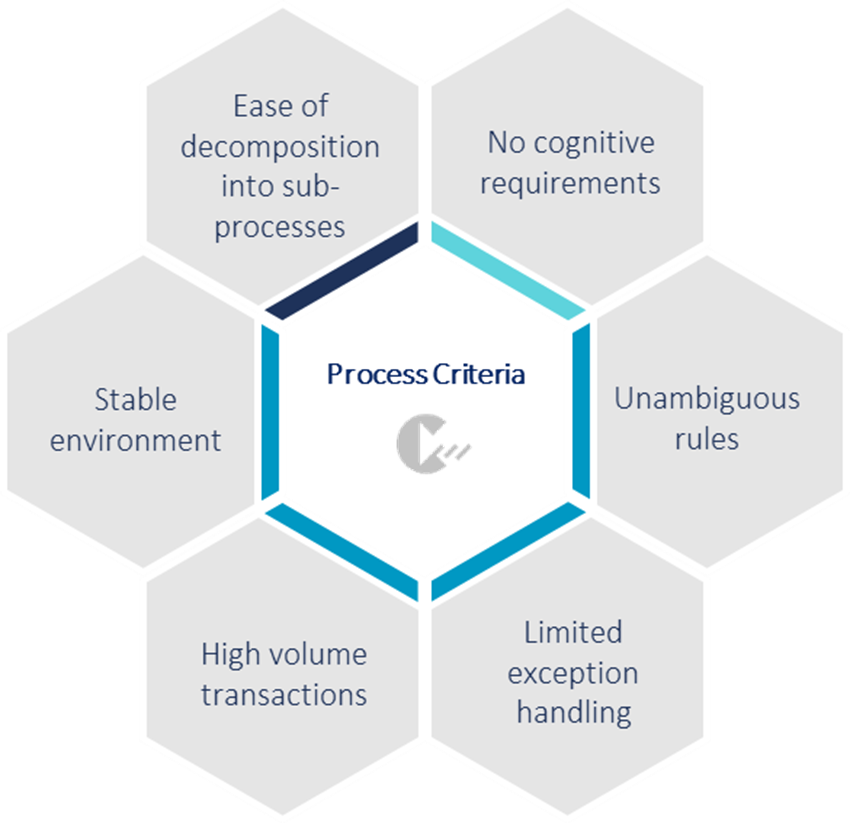How Value Mining helps to successfully drive intelligent automation in procurement Looking at our client base and beyond, process mining proof of concepts and implementation projects show a hypergrowth development. Especially in a procurement context, process mining is a too narrow description for what can actually be achieved with the technology. In the following article, we introduce Value Mining and explain the procurement journey towards an intelligent automation. Value Mining goes far beyond reducing process inefficiencies with the help of process mining technology. It allows to leverage data-driven insights, build operational resilience, and unlock hidden value, e.g. by realizing savings, improving stock availability, or increasing customer satisfaction.  Figure 1: Journey from Value Mining to intelligent automation
Figure 1: Journey from Value Mining to intelligent automation
Phase 1: the Value Mining pilot
The first phase in the journey from Value Mining to intelligent automation includes leveraging the process mining technology to gain true end-to-end transparency of how processes really run. Compared to time-consuming manual process mapping, which typically takes several weeks, process mining technology enables you to identify process breaks, inefficiencies, bottlenecks and further hidden value in real time and with an objective viewpoint. There are three major reasons to start your own Value Mining initiative in procurement: First, the list of potential Value Mining use cases and well-established analyses in the field of procurement is long. A lot of customer success stories, experiences and benchmarks already exist. Second, procurement has highly transactional sub-processes, as e.g. the purchase-to-order process. It is typically highly standardized. With a Value Mining initiative, impacts can be exactly measured and benefits quickly realized with less effort. Third, beside typical Value Mining benefits such as process efficiency and qualitative improvements, short-term bottom-line impact can be realized by cost saving initiatives e.g. through identifying options for order bundling, or by working capital improvements e.g. through optimizing payment terms.  Figure 2: Benefits of Value Mining in procurement Essential in the Value Mining pilot phase is not to lose the focus. Focus first on use cases with little implementation effort but quick results. Consequently communicate the value generated, gain futher support and a positive spirit for the pilot process cluster. Leverage objective data and storytelling to influence behavior and drive change internally.
Figure 2: Benefits of Value Mining in procurement Essential in the Value Mining pilot phase is not to lose the focus. Focus first on use cases with little implementation effort but quick results. Consequently communicate the value generated, gain futher support and a positive spirit for the pilot process cluster. Leverage objective data and storytelling to influence behavior and drive change internally.
Phase 2: Scale up to other process clusters
Once the successful pilot is completed, it is time to expand the procurement approach to further corporate process clusters. As procurement related processes, the subsequent accounts payable process or the highly transactional order-to-cash process are appropriate. The goal is to have a fritionless process lanscape under the umbrella of the Value Mining initiative.
Phase 3: From Value Mining to intelligent automation
The last phase of the journey focuses on automation. Already during the Value Mining Pilot there might be improvements focusing on increasing the automation rate of certain tasks in a process. However, only if all procurement-related processes are interlinked, a more matured application of RPA, artificial intelligence (AI) and machine learning (ML) tools and algorithms is possible. Typically, the starting point for automation is the application of RPA, meaning a configurable software tool to automate repetitive and rule-based business processes. Further, it is crucial to start with small process chunks which meet the right criteria.  Figure 3: Process criteria to apply RPA When rule-based RPA has reached its functional limit, AI and ML algorithms need to be developed to deal with more complex situations or prevent future process efficiencies. These additional AI-based rules will be combined with RPA to extend the functionality. One specific use case is the requisition-to-order process: the AI algorithm uses historical purchase order data to try to understand the reason why an experienced buyer selects a supplier for each item in a requisition. Every time the algorithm selects the right supplier, it is being ‘rewarded’, thus making reinforced learning of AI and further improving the automation accuracy. In the following, an RPA system might take over and send RfQs to those suppliers including a link to submit their offer. The system gathers all quotes or feedbacks and creates a selective overview of the buyer. The journey of digitization evolves in the first two phases just slightly, when fixing process frictions and unlocking value. In phase three (“Automate”), the digitization level rises exponentially as more and more tasks and processes are automated. Past non-automated tasks are being captured, detailed out, standardized, and automated. Procurement employees can more and more spend their time on value-adding, creative tasks instead of operational repetitive routine tasks. The future will be self-driving processes end-to-end. To sum up, an intelligent automation journey needs the joint forces of RPA, ML and AI technology and a Value Mining initiative at its core. Additionally, deploying the right people is key to drive the journey to success.
Figure 3: Process criteria to apply RPA When rule-based RPA has reached its functional limit, AI and ML algorithms need to be developed to deal with more complex situations or prevent future process efficiencies. These additional AI-based rules will be combined with RPA to extend the functionality. One specific use case is the requisition-to-order process: the AI algorithm uses historical purchase order data to try to understand the reason why an experienced buyer selects a supplier for each item in a requisition. Every time the algorithm selects the right supplier, it is being ‘rewarded’, thus making reinforced learning of AI and further improving the automation accuracy. In the following, an RPA system might take over and send RfQs to those suppliers including a link to submit their offer. The system gathers all quotes or feedbacks and creates a selective overview of the buyer. The journey of digitization evolves in the first two phases just slightly, when fixing process frictions and unlocking value. In phase three (“Automate”), the digitization level rises exponentially as more and more tasks and processes are automated. Past non-automated tasks are being captured, detailed out, standardized, and automated. Procurement employees can more and more spend their time on value-adding, creative tasks instead of operational repetitive routine tasks. The future will be self-driving processes end-to-end. To sum up, an intelligent automation journey needs the joint forces of RPA, ML and AI technology and a Value Mining initiative at its core. Additionally, deploying the right people is key to drive the journey to success.
We would like to thank Wolf Göhler and Kevin Tinnes for their contribution to this article.

